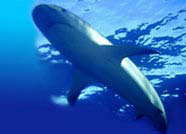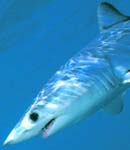


Modern Sharks

 |
 |
 |
|||
| Home | Evolution
| Classification
| Glossary | Biology
| Behavior | Shark
Repellent | Shark
Conservation | Do's &
Don'ts | Did You Know?
Modern Sharks |
 |
||||
|
|
||||||||||
|
 The
Jurassic and the Cretaceous period are often referred to as "Age
of Reptiles". In the sea, the relatives of dinosaurs included long-necked
plesiosaurs and shark-like ichthyosaurs; but the new breed of sharks streamlined,
fast swimming and equipped with their remarkable battery of senses were
strong competitors. Some were huge. The Cretoxyrhinid sharks, for instance,
were active hunters with lengths over 6 m (20 ft) and weights in excess
of 1.5 tons. The
Jurassic and the Cretaceous period are often referred to as "Age
of Reptiles". In the sea, the relatives of dinosaurs included long-necked
plesiosaurs and shark-like ichthyosaurs; but the new breed of sharks streamlined,
fast swimming and equipped with their remarkable battery of senses were
strong competitors. Some were huge. The Cretoxyrhinid sharks, for instance,
were active hunters with lengths over 6 m (20 ft) and weights in excess
of 1.5 tons. There were also the Ptychodonts, a group of sharks known only from their teeth. These were flattened, crushing structures, suitable for tackling hard-bodied creatures, such as ammonites, bivalves and gastropods. Cretaceous deposits also contain the teeth of what look remarkably like those of sand tiger sharks and there were the recognizable teeth of large lamnid sharks, relatives of today's mackerel sharks, from species that must have been over 6 m (20 ft) long. Fossil teeth from ancient porbeagles Lamna, for example, have been unearthed in rocks dating back to the Cretaceous. Period by period, sharks have survived major catastrophes on earth. After Permian Period mass destruction, there was another event that led to extinct of various life forms, including that of the biggest beings to have lived on earth-Dinosaurs. But sharks not only did survive these destructions, they evolved through it. The saw the mass destruction at the end of Triassic period, when about 20% of marine life was devastated, and at the end of Jurassic period, there was another minor event. Then they saw another major mass destruction, second only to the Permian destruction, at the end of Cretaceous period- 70% of all live forms including dinosaurs were wiped out. There was a distinct loss of diversity in the groups, but the survivors were a tough, well-honed bunch. These included great filter feeders, such as basking sharks Cetorhinus, straining the water for krill in the manner of modern baleen whales; also, tiny fossil teeth, closely resembling those from the mid-water filter-feeding megamouth Megachasma, have been found in Tertiary rocks. There were fast-swimming hunters, too, including a new group of sharks that would come to dominate the seas up until the present day. These were the carcharonids--the requiem sharks. With the demise of the giant reptiles, the mammals began to fill some of the vacated niches, and some returned to the sea. The evolving whales, dolphins, seals and sea cows became the main source of food for one group of sharks in particular the ancient relatives of the great white shark. The earliest fossil teeth resembling those of modern great whites were found in rocks about 65 million years old. Even at this early date, the great white's ancestors were poised in evolutionary terms to exploit the coming superabundance of blubber and meat, and some species took full advantage, including some of the most powerful predators known to have lived in the sea. Today, the last survivors are the great white shark and its close relatives the makos and porbeagles. Megalodon The species Carcharodon (Carcharocles) megalodon, often known as 'megatooth' or megalodon,  was
a real giant, even larger than the whale shark, the largest living shark.
An ancient relative of the great white shark, Megalodon was probably the
most formidable predator ever to have swum in the sea, and one of the
most dangerous animals ever to live on the planet. was
a real giant, even larger than the whale shark, the largest living shark.
An ancient relative of the great white shark, Megalodon was probably the
most formidable predator ever to have swum in the sea, and one of the
most dangerous animals ever to live on the planet. Megalodon fossils are generally found in near-shore deposits, indicating it probably lived in the coastal regions of warm seas. The profusion of fossils of sea mammals, such as whales and dolphins, in the same rocks suggests there was an abundance of prey for it to feed on. Megalodon reached its greatest length and size during the Miocene, about 12 million years ago. The largest specimens were estimated to have measured about 16.8 m (55 ft) long, weighed 25 tons, and possessed an immense mouth with a gape of about 2 m (6 ft) that could swallow five adult humans in one gulp. Its jaws were lined with 15 cm (6 in) long triangular, razor-sharp teeth. |
|
|||||||||
| Sitemap | Reach To Us | Jimtrade - Business Directory of India | ||||||||||